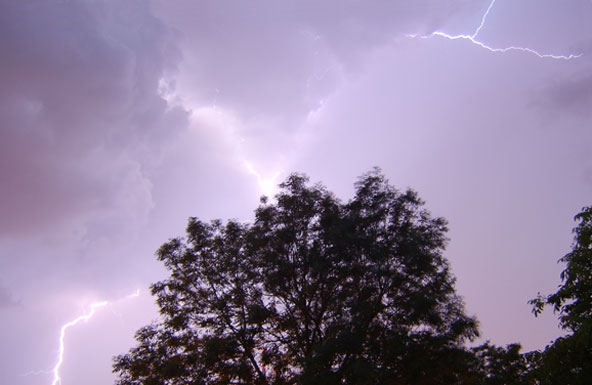If you live in a lightning-prone area, you’re aware of certain safety tips when a storm passes through. Venturing inside and staying away from metal objects are just common sense, but your favorite tree outside cannot hide from nature’s fury. In fact, trees are some of the most common items struck by lightning across the world. It’s important to have the skills to spot and protect these trees from potential electrical dangers. Tree death can by rapid when lightning is involved.
Consider the Species
It’s natural to look to the tallest tree and assume it will be damaged by lightning, but this fact isn’t always the case. Certain tree species actually attract lightning to some extent. Oak and ash trees, for instance, have a high risk of being struck. Reasons for their vulnerability involve height and their moisture content.
Because these species often have a lot of moisture throughout their systems, the water becomes a perfect conductor for the electrical charge. As a result, you’ll notice these species being damaged more often than other types, including beech and maple.
Location Speaks Volumes
When a tree is isolated and tall, both of these factors make them vulnerable to lightning strikes. Electrical charges that build up in the sky will eventually need to be released. Charged electrons will simply seek the path of least resistance. If a single tree stands tall in a field during an electrical storm, the branches become the perfect pathway for electricity to reach the ground.
If you spot one of these trees on your property, you should seriously consider a lightning-protection system. It will remain vulnerable to lightning without similar trees nearby or a protection installation.

Look Around Your Property
An isolated tree is an obvious lightning candidate, but there are other trees that you should also focus on. If you have a tree that’s about 10 feet away from a structure with branches hanging down over the roof, it might be vulnerable to lightning. An electrical charge striking the home can inadvertently run through the tree too.
Pruning the tree’s branches or transplanting it away from the home are two viable options that can reduce potential strikes. The home is also protected when the tree isn’t in physical contact with the structure.
Investing in Copper-Cable Systems
The best way to protect a tree from lightning is with a properly installed copper-cable system. Conductors placed at strategic branch locations will effectively draw the electrical charge from the sky. With hidden cables snaked between the conductors and the ground rods, any lightning will be instantly forced to the soil.
It will bypass the tree entirely while the ground rods allow the charge to safely dissipate into the earth. These systems can be expensive, however, so you should have a professional verify the particular tree that requires protection. Historic or exceptionally old trees are always good candidates.
It’s possible to save a tree after it’s been struck by lightning, but it depends on the damage’s extent. Water and fertilize the soil beneath the tree while patching up any physical damage to the bark and trunk. By reducing pest infestations into these damaged areas, your tree may have enough strength to grow new buds next season. Simply be aware of the weather in your area so that you’re ready for any lightning issues that might arise.
If you’re interested in tree trimming or stump removal try out Valley Tree Managers. They are a full service cactus, tree, and stump removal company who have been around for years!
